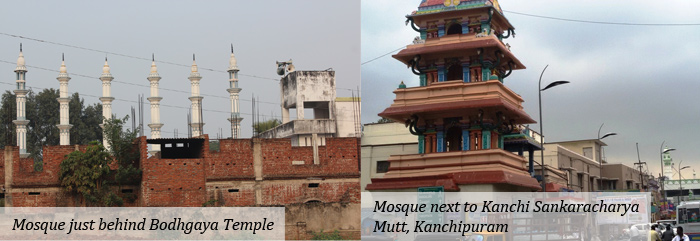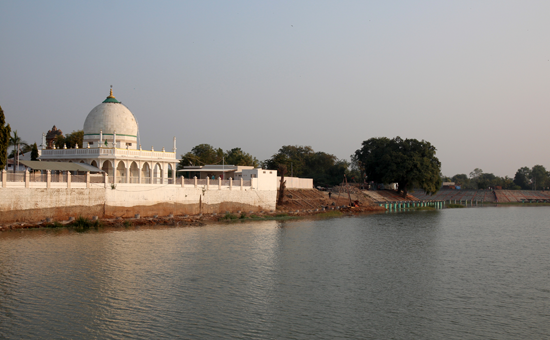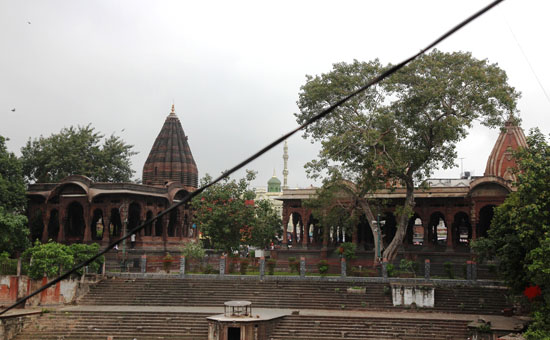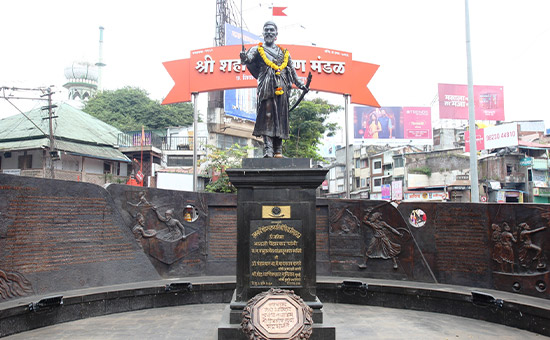- We try to understand why Hindus are protesting against namaz on public land. The protests are actually against what follows, a mosque and being disturbed by loudspeakers five times a day and two, the increasing number of mosques. Article is based on author’s travels across India.
During the last few weeks namaz on vacant grounds in Gurugram has been in the news. In June 2017 Muslims offered namaz on railway tracks in Delhi.
Liberals argue that Hindus have jagarattas and marriages on public land so what is wrong with namaz on vacant grounds. The comparison is inappropriate. These are held at specific times during the year and not every week. Two, they are festivals or celebrations and not prayers in public. Three, if Muslims are unable to accomodate their increasing population in mosques, they should hold namaz in shifts, inside mosques and clearly not on public land.
A community used to preferential treatment might wonder why Hindus are protesting now.
No wonder Thomas Powel wrote, “When people get used to preferential treatment, equal treatment seems like discrimination".
Now that matters have cooled down let us understand why Hindus are protesting against namaz on public land and indirectly against the increasing number of mosques in Hindu dominated areas.
Let us start with examples of mosques on public land.
1. According to local sources, Muslims in Nainital offered namaz on a road that connected the Mall road with the road that goes to the High Court. Since the road was used by those who worked in the High Court namaz caused great inconvenience. Judicial pressure was brought upon Muslims to stop offering namaz on the road in lieu of which the administration, without making it explicit, allowed the community to build a large mosque (a small one existed earlier) although new construction is not allowed in the area. Consequences are two -
Since it overlooks the Naini Lake the four storeyed masjid is amongst the first things tourists sees on entering Nainital and wonder if they have come to Kashmir.
Secondly and importantly the masjid (see above pic) dwarfs the Naini Mandir after which the hill station is named. This temple is one of the 51 Shakti Peeths, and finds mention in the Kushan period. Built in the 15th century AD, the murti was
installed in 1842. Devotees from far and wide come to offer prayers to Ma Naina
Devi.
By doing namaz on the road the community, apparently got a waiver on new construction and built a four storey structure i.e. not in sync with the environment and culture of Nainital.
2. In Uttar Pradesh a masjid was built on public land. Senior journalist Kanchan Gupta tweeted on May 7, “Remember young and feisty IAS officer Durga Shakti Nagpal and the wall she wanted demolished for which she was severely punished. And pro-SP, pro-Akhilesh #MSM kept quiet? The wall is now a multi-storey masjid on public land, the main road is jammed, and none remembers Durga Shakti’.
3. Again in Uttar Pradesh a masjid
was built inside the premises of the Allahabad
high court. In November 2017, the Allahabad High Court noted that due to the "acute crunch of space", the Waqf property spread over 400 metres was causing hindrance to the movement of the fire brigade in the premises of and then issued an order directing: "The unauthorised possession, as well as the unauthorised structures existing over the site in dispute, cannot be permitted to continue any longer." The matter is pending
before the Supreme Court.
How can
someone make an unauthorised mosque in the premises of an institution ie
supposed to uphold law?
4. A
mosque/dargah exists on a platform of New Delhi Railway Station and inside the premises of the Income-tax Office Aayankar Bhawan at Churchgate in Mumbai.
5. Next to Shahrukh Khan’s office in Santacruz Mumbai is a mosque amidst a slum ie on a small plot. Similarly when you exit the Worli Bandra sea-link there are numerous unauthorised hutments on the Rang Sharda side, one of which houses a mosque.
And mind you this is by no means an exhaustive list of unauthorised constructions.
It is not the author’s intent to state that Muslims should not be allowed to do namaz.
What is not being said is that namaz on public land is a prelude to construction of a mosque and being disturbed by azaan blaring from loudspeakers.
Hindus have also noted that during the 1990 Kashmir Pandit exodus from the Valley and to this day loudspeakers in mosques are used for crowd mobilization.
Thus Hindus are protesting both for historical and current reasons.
During
the medieval period there was large-scale destruction of temples for e.g. at
Varanasi, Mathura and Ayodhya. The equivalent of such destruction in
contemporary India is making mosques close to revered Hindu places of worship
and in Hindu dominated areas.
By virtue of having travelled across the country the statement is substantiated with examples . Year after name of temple indicates year of author’s visit.

1. Bodh Gaya Temple, Bihar
2012
Whilst meditating with Buddhists from Thailand and Myanmar, we were
disturbed by azaan. The Buddhists later asked why the Government
did not stop this as Bodh Gaya was the most sacred place for Buddhists
worldwide. On inquiry was told it is a 300-year-old mosque, recently renovated,
whose minarets had numerous loudspeakers.
2. Kanchipuram, Tamil Nadu 2016
Sri Kanchi Kamakoti Peetham is an old and revered institution headquartered in Kanchipuram. It is believed that “Sankara Bhagavapadacharya retired to Kanchi, the Southern Mokshapuri, and shook off his mortal coils in that sacred city.” The Peetham is very important to Hindus. A large mosque with at least eight loudspeakers adjoins the peetham.
 Mosque Vadnagar. Note embankment on right of pic doe not appear in mosque area.
Mosque Vadnagar. Note embankment on right of pic doe not appear in mosque area.
3.
Vadnagar Gujarat 2018
The
home town of Prime Minister Modi is famous for its torans that were constructed
by Solanki rulers in commemoration of a decisive victory.
Just
opposite these torans is a newly
built mosque (the earlier one was smaller) on the banks of the Sharmistha Talav.
According to locals the embankment of the talav was used to increase the area available for the
new mosque, perhaps to make it bigger.
This way everyone who comes to see the toran, wonders of architecture,
has to see the mosque too.
4. Leh Palace 2016
The palace dominates Leh. A mosque existed in the Leh market and close
to the palace for atleast 250 years said locals. A bigger mosque was recently
built.
It now extends to a height whereby when you see the palace you see the mosque. If you attempt a wide angle picture of the historic Leh Palace the mosque features too.
5. Chetak Circle Udaipur 2017
Inspite of being deeply wounded, Chetak the horse of Maharana Pratap, galloped for six kms enabling Pratap’s safe exit. In honour exists Chetak circle symbolised by a white horse in the circle.
On one side of Chetak Circle is a mosque and another is 7 odd storey
building that dwarfs the gallant Chetak.
6. Mysore Palace Outside 2017
Minutes away from the Jayarama and Balarama entrances to the palace is a
recently constructed mosque. Azaan volumes over loudspeakers is loud enough for
all to hear far and wide.
7. Shivaji Temple Chennai 2016
In the George town area of Chennai is the Kalikambal temple that Shivaji
Maharaj visited in 1677. In the next lane is a huge mosque.
8. Main market Ujjain 2006
The Sri Gopal Mandir was built by the Scindias about 250 years ago.
Temple shikhar dominates the market. Minutes away and also in the market came
up a masjid whose minaret is as tall if not taller than the shikhar.
9. Mata No Madh Kutch 2018
The temple is amongst the most sacred shrines in Kutch and is dedicated to Ashapura Mata. The Jadeja Rajputs, who ruled Kutch, were ardent devotees of Ashapuraji whom they considered as their guardian deity. The battle cry of the Jadejas was ‘Jai Ashapura’.
As one walks out of the temple onto the main road is a mosque.
10. Sachiya Mata Temple, Osian
Rajasthan 2013
The Sachiya Mata temple near Jodhpur was originally built in the 8th century; the current complex dates to the 12th century. The temple attracts Hindu and Jain devotees.
Minutes away from the entrance is a mosque. When one asked a temple priest if they protested when mosque was being constructed and if they were disturbed by azaan, he snapped, “Ayodhya mein kuch nahin kar paye tho idhar kya kareege” (Could not do anything in Ayodhya then what can be done here).
11. Bagnath Temple, Bageshwar,
Uttarakhand 2012
Across the river and opposite the Bagnath Temple that was built in 1602 stands a recently built mosque.
 Chhatris of Holkars with Mosque in between.
Chhatris of Holkars with Mosque in between.
12. Chhatris of Holkar, Indore 2018
Enroute to Rajwada, on the banks of a river are chhatris of the Holkar rulers. When you view the chhatris from across the river, in between two of them is a mosque that you see in the pic.
13. Shivaji Maharaj Chowk, Kolhapur 2019
On left of pic is a mosque. When you click a pic of Shivaji Maharaj the mosque has to come. Minutes away is the Mahalaxmi Mandir.
 Shivaji Maharaj Chowk, Kolhapur.
Shivaji Maharaj Chowk, Kolhapur.
Is it a matter of coincidence that these mosques are close to prominent places
of worship and or historical places associated with Hindus?
In the normal course of things Hindus would not object to the
construction of a mosque. Loudspeakers during azaan is what people, including
many Muslims, object to.
An eighty three year old once upon a time resident of Delhi’s walled city in the 1950’s fondly recalls how musical azaan sounded in
the pre-loudspeaker era.
Today azaan is heard far away and disturbs all living beings, humans and animals included. It is a different matter that loudspeakers are played before 6 am and at volumes that violate the 2005 Supreme Court Order on loudspeakers.
Unless Muslims stop offering namaz in public, use of loudspeakers during azaan and building mosques close to Hindus places of worship we are likely to witness an increase in social disharmony on account of mosque building.
Also read
1. Azaan is increasing the communal gap
2. Muslim leaders welcome Bombay High Court order on loudspeakers
3. To read 2005 SC Order on loudspeakers
4. Understanding the Muslim mind through Dr Ambedkar's writings